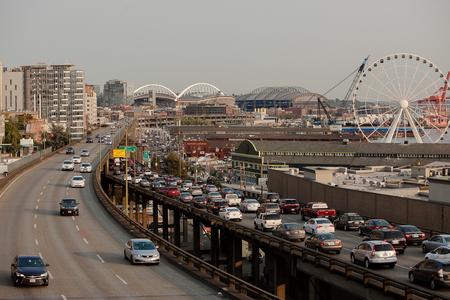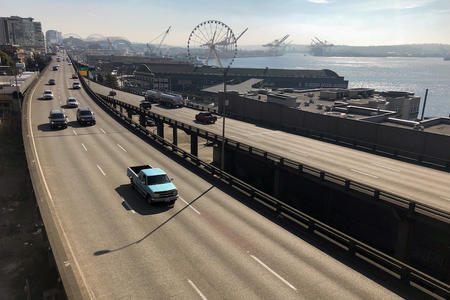Councilmember Mike O’Brien explained the change will give council staff and the public more time to get to meetings in the morning and a chance to get out of City Hall before the afternoon rush hour. “This will obviously not drastically change commute patterns across the city. But it’s a small step,” he said at Monday’s council meeting.
The city is hoping a lot of little steps, such as extra bus lanes, added ferry service, on-demand shuttles in West Seattle, pick-up and drop-off zones for ride-hailing companies and extra car lanes created by removing parking from some downtown streets, will add up to help ease the pain of the “Seattle Squeeze” — the coming gridlock caused by the Highway 99 closure and other major construction downtown. A key part of their strategy to reduce the rush hour logjam is encouraging downtown employees to shift from a standard 9 to 5 schedule to earlier or later schedules or to work from home.
In an effort to be a “model employer,” Mayor Jenny Durkan directed all departments to make plans to allow alternative work schedules for city employees from Jan. 2 through March 31, whether adjusting work hours or telecommuting. The directive lays the groundwork for a broader shift in work culture that city employees have wanted for years.

Some 7,000 city of Seattle employees work in downtown offices, making the city the third largest employer after Amazon and Swedish Hospital on First Hill. Only 10 percent of city employees working downtown drive alone, compared with 25 percent of all downtown employees, but a mayor’s office spokesperson explained the changes are as much about freeing up space on mass transit as it is about getting drivers off the road.
Not every city employee can work remotely or shift schedules. But the mayor’s office said city departments must now justify why an employee cannot have a flexible schedule, instead of why they can. That extends beyond desk jobs. In the interest of equity, the mayor’s office said it is asking departments to figure out alternative schedules for “all job classifications,” meaning cleaning staff should have the option to shift their work schedules as readily as managers.
“These are things that our members have long been clamoring for,” said Shaun Van Eyk, a union representative with PROTEC17, which represents about 3,000 city of Seattle employees. “Some departments are way ahead of the curve and some are way behind. … Mostly it’s the larger engineering-focused departments that have been recalcitrant in the past.”
Like just about everyone in Seattle, city employees are also concerned about the shutdown, Van Eyk said. “More and more with cost of living in the city, we have members and particularly younger employees who are living well outside city limits," he said. "Commuting in and out is a huge impact for them.”
About 13 percent of downtown city employees have signed up for alternative work schedules so far. The city’s goal is to get that to at least 20 percent. The experiment with alternative schedules is meant to lay the groundwork for the long term. Doing so, Durkan wrote in an email to city staff will help “move us forward as an employer to attract and retain the best and brightest employees.”
Up in north Seattle’s District 5, Councilmember Debora Juarez will hold all constituent meetings out of her district office at North Seattle College for the time being so D5 residents “do not have to fight the Squeeze" to meet with her downtown.
For those who have no choice but to stomach the gridlock, the council member is trying to get creative by is hosting a “D5 Book Club” with weekly book recommendations for people spending extra time commuting on the bus. The club will culminate with a meeting at the Lake City Library later this year.
The D5 Book Club reading list: ThereThere by Tommy Orange, Native Seattle by Coll Thrush, Becoming by Michelle Obama, Lake City by Thomas Kohnstamm and The Best We Could Do by Thi Bui.
Update: This story has been updated with more details about council member plans for the 99 shutdown.







